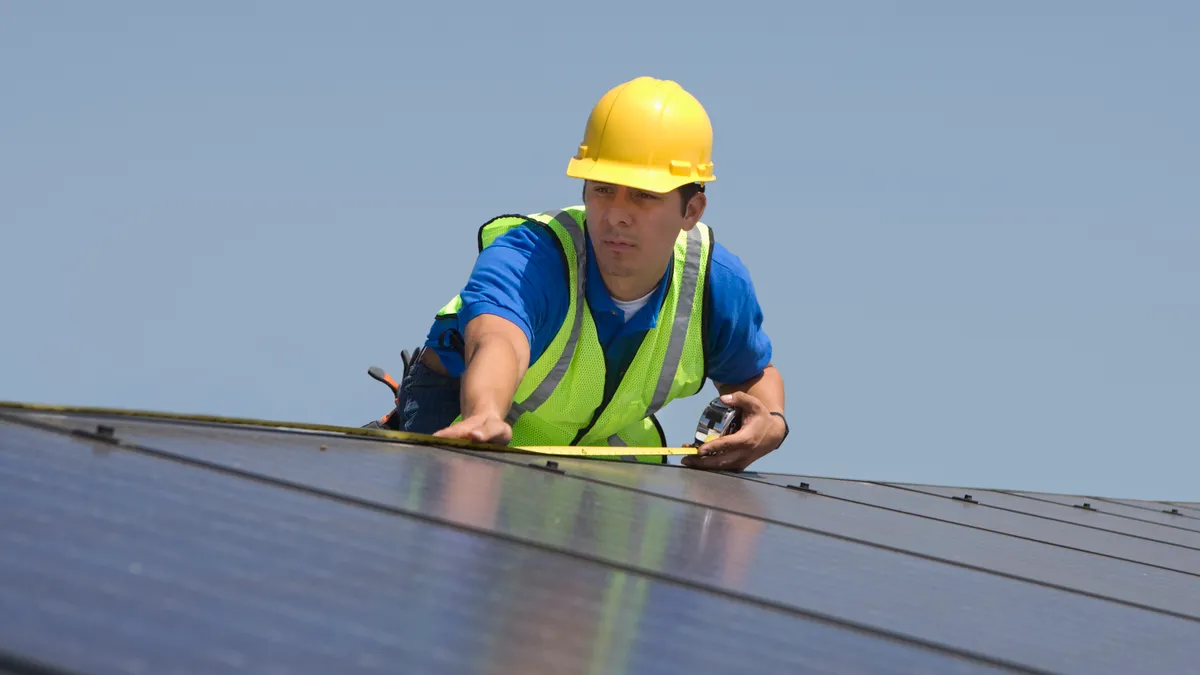Dive Brief:
- Storage attachment rates on new residential photovoltaic systems in California spiked from about 10% to approximately 60% following the April 2023 enactment of the state’s net energy metering tariff, known as NEM 3.0, net billing tariff or NBT, Lawrence Berkeley National Laboratory said in a technical brief released earlier this month.
- Median inflation-adjusted costs for solar-and-storage systems rose 17% under NBT, possibly due to a surge in customer demand and related shortages of storage attachments and trained installers, the brief said. Meanwhile, the average size of solar-plus-storage systems declined 17% and the market share of the state’s top five installers grew from 40% to 51% as the industry worked through a backlog of projects approved under the old rules. Most of the market share increase was attributable to the state’s largest installer, LBNL said.
- “This has been a year of transition” for California’s residential energy generation industry, brief author Galen Barbose, staff scientist in the Energy Markets and Policy Department at LBNL, told Utility Dive.
Dive Insight:
NEM 3.0 reduces residential PV system owners’ earnings from electricity exported to the grid, incentivizing storage attachments, according to the LBNL report. The new framework covers systems that applied for interconnection after April 15, 2023.
California saw a surge in interconnection applications for “grandfathered” systems during the first quarter of 2023, creating an ongoing installation backlog. About 50,000 residential PV systems have interconnected under the new NBT rules, mostly in late 2023 and early 2024, compared with about 200,000 systems interconnected under the old NEM rules during the same time frame, the brief said.
Because the market is in a transitional period, it may be too early to draw sweeping conclusions about the impact of NEM 3.0 on the residential PV industry.
“We should know more in the next six to 12 months,” Barbose said.
Still, with the majority of residential PV systems attached to battery storage, it’s already clear that “the market has very much pivoted to paired solar-plus-storage under net billing,” he said.
This shift could herald a shakeout in California’s residential distributed generation industry. Though approximately 2,500 PV installation companies installed at least one system in the 12 months since NBT’s implementation, only half completed an installation under the actual NBT framework, with the rest grandfathered under the old NEM rules, the brief said.
Alongside the market share increase for top installers, “these data suggest the possibility of significant consolidation within the California residential PV installer market,” the brief said. The “vast majority” of California PV installers install fewer than 10 systems per year, and many are roofers or electricians that install solar as a side business, Barbose noted.
“Companies whose primary business is something other than solar may move away from solar,” he said.
The study period also saw a significant increase in third-party ownership of residential PV systems in California, from “26% for stand-alone PV and 11% for paired PV+storage [under the final 12 months of the old NEM rules to] 39% and 52%, respectively, under NBT,” according to the brief.
Top installers’ market share growth may have contributed to the jump because larger companies are more likely to offer third-party ownership, but other factors such as higher interest rates, bonus IRA credits only available to third-party systems and a higher share of systems on newly built houses likely also played a role, the brief said.
One other notable and “unexpected” finding was a marked shift in PV installations toward lower-income ZIP codes, Barbose said.
The shift was “especially pronounced” for storage-attached installations, LBNL said. This may reflect that most installations under NBT involved new construction, which tends to occur in a broader range of ZIP codes that are collectively “more representative of the state as a whole” than the affluent ZIP codes where PV retrofits tend to concentrate, Barbose said.
Additionally, the brief flagged other factors that may have contributed to the income shift, including temporary PV-adoption incentives for low-and-moderate income households under NBT, bonus Inflation Reduction Act tax credits and other California programs designed to reduce the upfront cost of solar-and-storage systems for lower-income customers.













